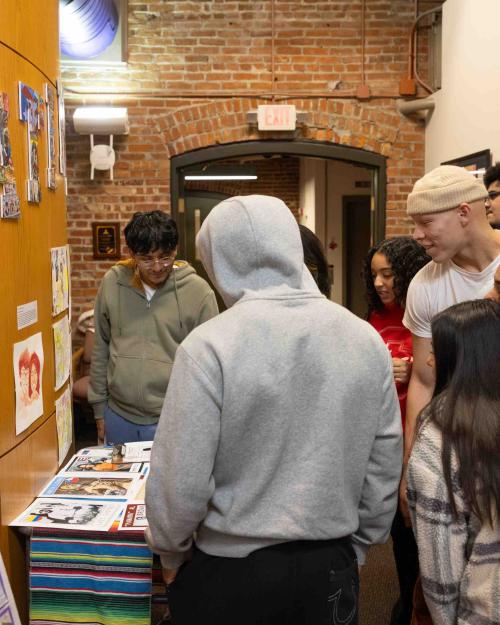On Dec. 4, nearly 60 students from Cornell’s Introduction to Latinx Studies course celebrated Latino/a roots through their exhibit “Cultura y poder.” Their collaborative mixed media projects, showcased online and in 434 Rockefeller Hall, explore how culture strengthens and uplifts communities.
After a semester dedicated to studying the experiences and intersections of U.S. Latinx identities, Professor Debra Castillo and doctoral student Carolina Osorio Gil challenged students to explore in-class themes without boundaries.
Castillo, the Stephen H. Weiss Presidential Fellow and Emerson Hinchliff Professor of Hispanic Studies, said the exhibit was created for two reasons. “One of the things we wanted to privilege in this course was the stories that people had about their own culture and their own family and how knowing more about their cultural background and the connections with other people’s cultures really empowers them” she said. Second, it was essential that the project be widely shared. “Sharing it with everyone is also part of creating community and we really wanted this to be a community space.”
During the event, students laughed, ate, and learned together, eager to share their stories and learn from classmates. From a zine embracing Afro-Latina identity, culture, and heritage to “Melissa: An American Doll,” inspired by countless unrepresented immigrant children, the exhibition was a love letter to Latinx culture.
Students lined the hall with plates of Argentinian dulce de leche-filled treats called alfajores; roasted and seasoned guinea pig from Ecuador called cuy and pernil, a staple dish at Puerto Rican celebrations.
Noëlle Romero 24’, the student and chef behind the pernil, shared that cooking her family’s classic Thanksgiving dish helped her reconnect with Puerto Rican roots. “I can’t really speak Spanish…, but through food, I was able to connect,” she said.
Romero thanked the class for teaching her, “It’s never too late to connect or reconnect with your culture,” she said.“I think I’ve just been scared to do that for so long, but this class has given me a lot of confidence, and I feel really good going forward.”
The class projects are all available to view on the exhibit site, where students link to their stories, podcasts and videos. One essay, "Language for the Generations: Multilingualism at its Best," by Michell Sanchez-Pantino ‘25, explores the author's experience with bilingualism and the dynamics of a multilingual family. Sanchez-Pantino reflects on the role of code-switching and the concept of being “fully bilingual,” concluding with the importance of maintaining heritage language.
Other poems and soundtracks explore themes from Latinx communities such as Dominican Americans, Puerto Ricans and Cuban Americans. Collectively, these pieces emphasize the cultural diversity of the Latinx community, originating from various countries. “Everyone has a story, and everyone’s story is worth telling,” Castillo said.
“People should come see so their eyes are opened to different cultures,” said Catherine Martin, 23’. “It’s so easy to only understand where our family comes from, whereas learning from other cultures, we’re able to learn different perspectives.”
“Symbolically, what we're doing at the end of the course is saying, ‘Here's your space. We're handing you over to your space,’ ” Castillo said.
Hannah Mitchell is a communications assistant for The College of Arts & Sciences.





